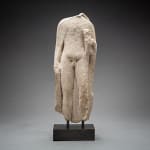Hellenistic Torso, 300 BCE - 100 BCE
Limestone
27.8 x 10.5 cm
11 x 4 1/8 in
11 x 4 1/8 in
PH.0173 B
Further images
The personal identity of this headless figure remains uncertain, nevertheless, we have reason to believe that this sculpture represents a standing dignified figure, adopting a strong stance and holding onto...
The personal identity of this headless figure remains uncertain, nevertheless, we have reason to believe that this sculpture represents a standing dignified figure, adopting a strong stance and holding onto a document holder in his left hand. Wearing a cloth draped over his back, the front reveals a male nude.
The term Hellenistic refers to the expansion of Greek imperialism following the death of Alexander the Great in 323 BC, followed by the Roman conquest consequentially usurped by Ptolemaic Egypt in 31 BCE following the Battle of Actium. Art from this period encompasses numerous regions and cultures often put under the heading of "Hellenistic Art" for convenience. As the human body was both secular and sacred, with the greeks seeing their gods as anthropomorphic, the representation of the human body was the most important subject for artistic endeavour during this period, and sculpture shifted towards increasing naturalism.
The term Hellenistic refers to the expansion of Greek imperialism following the death of Alexander the Great in 323 BC, followed by the Roman conquest consequentially usurped by Ptolemaic Egypt in 31 BCE following the Battle of Actium. Art from this period encompasses numerous regions and cultures often put under the heading of "Hellenistic Art" for convenience. As the human body was both secular and sacred, with the greeks seeing their gods as anthropomorphic, the representation of the human body was the most important subject for artistic endeavour during this period, and sculpture shifted towards increasing naturalism.





